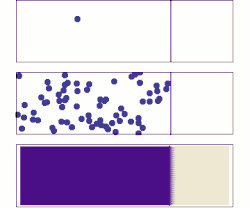Our website is made possible by displaying online advertisements to our visitors.
Please consider supporting us by disabling your ad blocker.
Fick's laws of diffusion

Fick's laws of diffusion describe diffusion and were first posited by Adolf Fick in 1855 on the basis of largely experimental results. They can be used to solve for the diffusion coefficient, D. Fick's first law can be used to derive his second law which in turn is identical to the diffusion equation.
Fick's first law: Movement of particles from high to low concentration (diffusive flux) is directly proportional to the particle's concentration gradient.[1]
Fick's second law: Prediction of change in concentration gradient with time due to diffusion.
A diffusion process that obeys Fick's laws is called normal or Fickian diffusion; otherwise, it is called anomalous diffusion or non-Fickian diffusion.
- ^ Vallero, Daniel A. (2024). "Physical transport of air pollutants". Air Pollution Calculations. pp. 163–190. doi:10.1016/B978-0-443-13987-1.00017-X. ISBN 978-0-443-13987-1.
Previous Page Next Page


